The 1920s was a decade of new inventions. This was the time directly after World War I, and when soldiers were eager to return to a more prosperous life. To help them enjoy their new lives new technologiessuch as the radio, silent movies and Henry Ford’s automobile industry were invented.
source ^ 1920 technology
Radio; Most radio historians asert that radio broadcasting began in 1920 with the historic broadcast of KDKA. Few people actually heard the voices and music which were produced because of the dearth of radio receivers at that time. The public, however, was overcome by a radio craze after the initial broadcast.
source ^ 1920 radio
Cameras;
source; http://licm.org.uk/livingImage/1920Room.html
Vintage film cameras;
1900
1900s, vintage cameras are predominantly constructed of wood, metal parts are usually brass -occasionally nickel plated and bellows are often fashionably maroon in colour.Prior to this, antique cameras in the 19th century were also mostly of wood ,quite often lacquered rather than covered in leather, the early bellows types often had square cut corners – see ‘bellows cameras‘. The earliest cameras, say 1850s to 1860s, were often formed by two rigid boxes, one inside the other, unfortunately the LICM currently has no examples.
Kodak, various box cameras representing 1901 – 1933
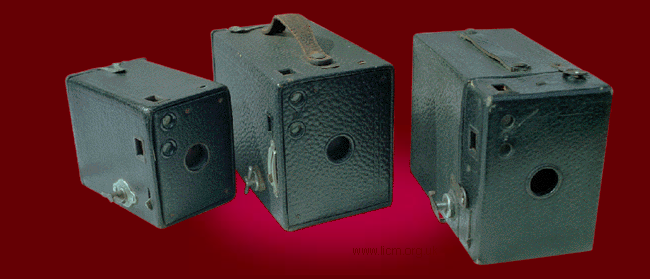
So many box cameras were produced by various companies it would be difficult to list them all. They are extremely common and can be picked up for as little as £1.
Butchers “The Midg” Falling quarter plate camera, c1905
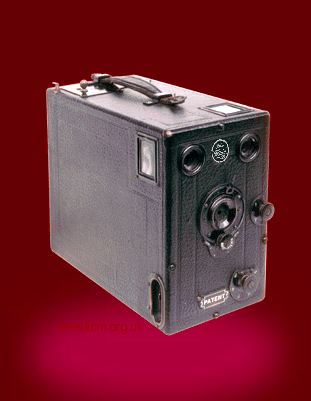
Box form ‘falling plate’ camera , manufactured with variations from 1902 -1920, for twelve plates 4.1/4 x 3.1/4″. Glass plates were loaded into carriers which slid onto rails in the back of the camera, the plate change mechanism caused the exposed plate to fall forwards into the bottom of the camera, whilst the next in line moved forwards under the pressure from a fairly hefty spring mounted on an internal hinged plate. This camera was probably made in Germany before WW1.
Kodak No. 3 Folding Pocket Kodak, Model E2. 118 rollfilm camera, c1904
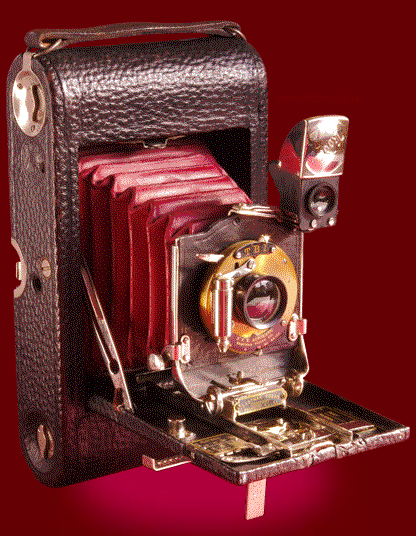
This No.3 Folding Pocket Kodak E2 is a development of earlier models introduced in 1900 identified by their boxed in leather shutter mechanisms, the E model arrived from 1904. The format is the same as quarter plate at 4.25 x 3.25″ but with the convenience of 118 roll film.
Thornton Pickard Double extension quarter plate camera, c1905-ish!
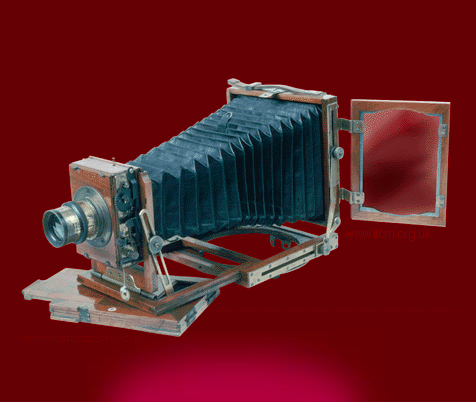
Thornton Pickard camera, an English mahogany & brass, double extension field camera with Thornton Pickard roller shutter, twin rack and pinion focus with rise and fall movements.
Butchers, Quarter Plate camera ‘The Cameo’, c1910
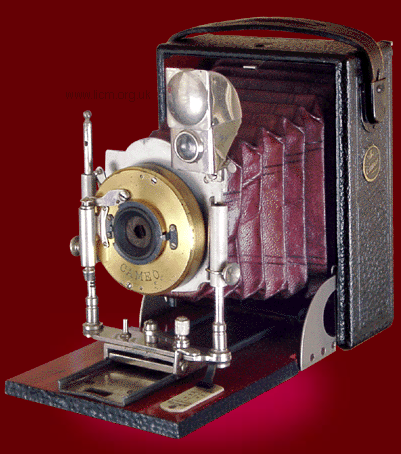
W Butcher & Sons Cameo, an imported German, Mahogany (or maybe rosewood), brass camera with nickel plated fitments, for glass plates. Probably manufactured by Ica.
FEW MORE IMAGES OF MORE CAMERAS IN 1900
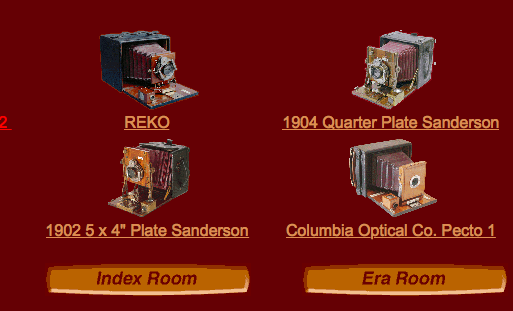
1910’S
During the 1910s, old fashioned cameras are mainly wood, nickel plated parts are more common than lacquered brass, roll film becomes increasingly commonplace and red or maroon bellows go out of fashion towards the end of the period.
1920’S
Houghton, Ensign Focal Plane roll film Reflex, 120 SLR camera, c1925
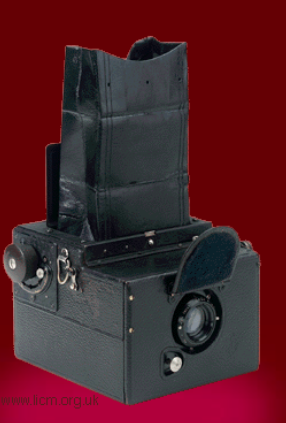
Ensign Focal Plane Roll Film Reflex – subsequently called the Ensign Speed Reflex, this camera was added to the collection in 1996 to represent the beginnings of the Single Lens Reflex (SLR) revolution.
Houghton Vest Pocket Ensign, folding strut braced camera. c1926
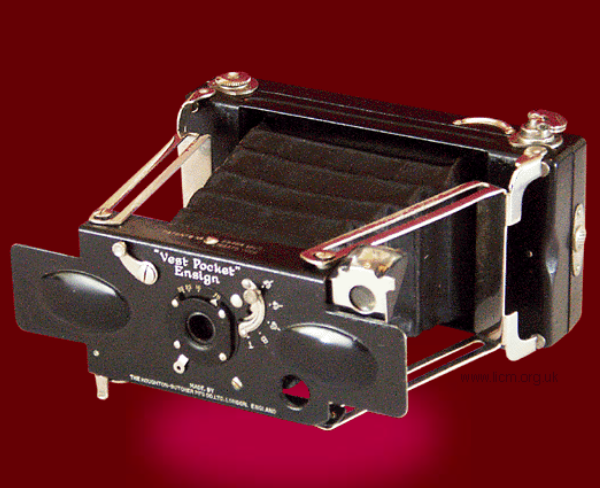
The Vest ocket Ensign, made from folded aluminium, The Houghton-Butcher manufacturing Co.Ltd, is stamped into the front of this pretty little 127 roll film camera. As yet not formally identified, it is devoid of markings, bar a stamping on the base and the lens, which is of a type I have seen attributed to Hutig – a German company which merged with a number of others in 1909. This doesn’t tally with the cast aluminium lensboard supports, which started to appear around the 20’s.
The rest of the 1920 cameras;
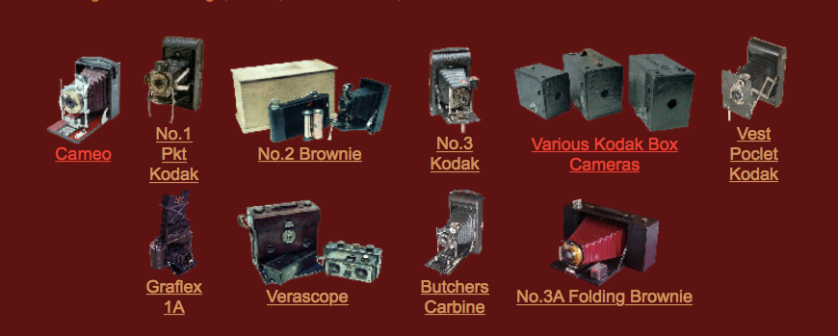
1920 telephone
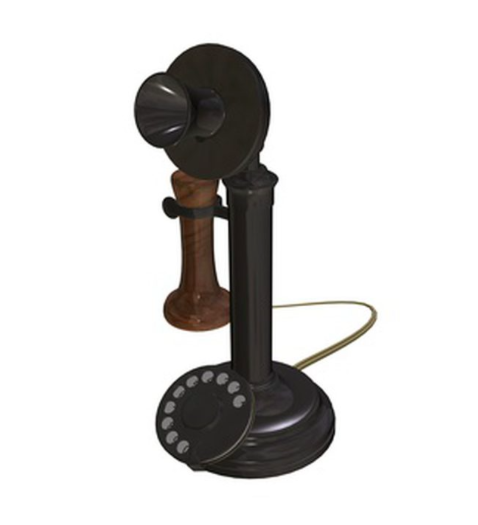
Candlestick Design
This classic design is what most people imagine when they think of old-fashioned telephones. It consisted of a stand, not unlike a candlestick, into which you spoke, and a handheld listening device attached to the side of the main stand. This was still in wide use in the 1920s, but would soon be replaced by a similar design with a dial on the front for calling numbers directly.
source; https://www.techwalla.com/articles/telephones-in-the-1920s
Technological Innovation Time Line
|
1865 on |
A general trend of mass production, standardized parts, assembly-line production (that dates from before 1865) transforms industry and labor and increases the availability of consumer goods. |
|
1869 |
The first Transcontinental Railroad is completed when the Central Pacific Railroad meets the Union Pacific Railroad at Promontory Summit, Utah. This officially connected the United States by rail, reducing a journey that had once taken four to six months to one lasting six days. |
|
1874 |
Christopher Sholes invents the “Sholes and Glidden Type Writer.” The QWERTY keyboard layout helps typists to increase their typing speed, thus increasing the efficiency of clerical workers. |
|
1876 |
Alexander G. Bell invents the telephone, which improves business communications. |
|
1877 |
Thomas Edison invents the phonograph. Edison suggests household uses such as dictation, letter writing, phonographic books for the blind, recording family members’ voices, and recording tele- phone conversations. |
|
1878 |
Edison founds the Edison Electric Light Company, which provides support for Edison’s electric light experiments in exchange for ownership of resulting patents. This provides further financial support for Edison’s inventions. |
|
1879 |
Edison invents the first commercially viable incandescent light bulb through the following innova- tions: lower current electricity, a small carbonized filament, and an improved vacuum inside the bulb’s globe. |
|
1879 |
James Ritty and John Birch patent the cash register, which helps to streamline the retail industry. |
|
1880s |
Frederick W. Taylor (Taylorism) and the Scientific Management/Efficiency Movement standardize workflow processes, including time studies and the division of labor, to improve labor productivity. In 1911, Taylor publishes The Principles of Scientific Management which codifies his ideas. |
|
1880 |
James Bonsack invents the cigarette rolling machine, which increases the speed of cigarette production. |
|
1881 |
Lewis Latimer and Joseph Nichols patent an electric lamp that has an inexpensive and long-lasting carbon filament. This improvement on Thomas Edison’s original design improved access to more efficient, longer lasting sources of electricity. |
|
1887 |
Granville Woods patents the Synchronous Multiplex Railway Telegraph, which allows moving trains to communicate with train stations, thus significantly increasing railway safety. |
|
1891 |
Edison invents and patents the motion picture camera, which makes it possible to record, reproduce, and project motion pictures. |
|
1890s |
The Electric trolley replaces horse-drawn mass transit. Frank Sprague is credited with improving the electric trolley concept, having developed the world’s first successful electric street railway system in 1887 in Richmond, Virginia. |
|
1897 |
Andrew Beard patents the Jenny Coupler, which allows railway cars to join together simply by bumping into one another. The Jenny Coupler increase railway safety by replacing the manual proc- ess of joining railway cars together (Beard himself had lost a leg in car coupling accident). |
|
1906 |
Ernst Alexanderson builds a high-frequency alternator, which allows radio to be broadcast in a continuous wave. This leads to the world’s first radio program with voice and music. |
|
1908 |
Henry Ford introduces the first Model T, the first mass-produced automobile. Ford’s desire to produce the Model T in a more efficient manner ushers in the advent of the assembly line. |
|
1913 |
Ford begins moving assembly-line production, based on the following principles: interchangeable parts, continuous flow, division of labor, and reducing wasted effort. The assembly line allows Ford to produce automobiles more cheaply, thus allowing him to sell his product at a lower price while still making a profit. |


